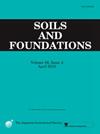稻壳生物废弃物升级利用改善水泥基泥炭土稳定性
IF 3.3
2区 工程技术
Q2 ENGINEERING, GEOLOGICAL
引用次数: 0
摘要
传统的稳定剂,如高岭土和钠基膨润土,在应用于水泥基泥炭土稳定时引入了复杂性。本研究探索了生物废物稳定剂——稻壳灰(RHA)作为火山灰材料和稻壳纤维(RHF)作为增强剂——作为一种可持续和实用的替代品。设计了一个三阶段的实验策略来确定最优的稳定方法。第1阶段确定了理想的RHA粒度和含量,没有RHF。第二阶段纳入RHF,评价其最佳预处理方法和最佳剂量;第三阶段研究了稳定机制。一系列物理力学实验证实,RHA和RHF改善了水泥基泥炭土的稳定性。RHA作为火山灰材料起主要作用,而RHF作为补强剂起次要作用。无侧限抗压强度(UCS)与水泥相比,单独使用RHA可提高146.6%,同时使用RHA和RHF可提高202.1%。这是通过使用精细的RHA颗粒和Ca(OH)2处理的RHF来实现的。RHA和RHF的含量都是至关重要的,特别是RHA的最佳含量随着水泥含量的变化而变化。微观分析证实,RHA增强了火山灰反应,产生了更多的胶凝产物(C-S-H),这些胶凝产物填充了孔隙并粘合了土壤颗粒。此外,预处理后的RHF粗糙表面上形成了大量胶凝产物,加强了土壤-纤维的结合。与仅使用水泥相比,通过升级利用生物垃圾稳定1立方米泥炭土可减少61.9%的碳排放和25.8%的成本。该研究表明,生物垃圾的升级利用为改善水泥基泥炭土的稳定性提供了一种有效、可持续、经济且易于实施的解决方案。本文章由计算机程序翻译,如有差异,请以英文原文为准。
Upcycling rice husk biowaste to improve cement-based peat soil stabilization
Traditional stabilizers, such as kaolin and sodium bentonite, introduce complications when applied to cement-based peat soil stabilization. This study explores biowaste stabilizers – rice husk ash (RHA) as a pozzolan material and rice husk fiber (RHF) as reinforcing – as a sustainable and practical alternative. A three-stage experimental strategy was designed to identify the optimal stabilization method. Stage 1 determined the ideal RHA particle size and content without RHF. Stage 2 incorporated RHF to assess its best pretreatment method and optimal dosage; Stage 3 investigated the stabilization mechanisms. A series of physical and mechanical experiments confirmed that RHA and RHF improved cement-based peat soil stabilization. RHA played a primary role as a pozzolanic material, while RHF is secondary as reinforcement. Unconfined compressive strength (UCS) increased by 146.6 % with RHA alone and by 202.1 % with both RHA and RHF compared to cement only. This is achieved by using fine RHA particles and Ca(OH)2-treated RHF. The content for both RHA and RHF is critical, especially noting that the optimal content of RHA varies as the cement content varies. Microscopic analysis confirmed that RHA enhanced pozzolanic reaction, producing more cementitious products (C-S-H) that filled pores and bonded soil particles. Additionally, a significant quantity of cementitious products formed on the coarse surface of pre-treated RHF, reinforcing soil-fiber bonding. Stabilizing 1 m3 of peat soil by upcycling biowaste reduces carbon emissions by 61.9 % and costs by 25.8 % compared to using cement only. This study demonstrates that upcycling biowaste provides an effective, sustainable, economical, and easy-to-implement solution for improving cement-based peat soil stabilization.
求助全文
通过发布文献求助,成功后即可免费获取论文全文。
去求助
来源期刊

Soils and Foundations
工程技术-地球科学综合
CiteScore
6.40
自引率
8.10%
发文量
99
审稿时长
5 months
期刊介绍:
Soils and Foundations is one of the leading journals in the field of soil mechanics and geotechnical engineering. It is the official journal of the Japanese Geotechnical Society (JGS)., The journal publishes a variety of original research paper, technical reports, technical notes, as well as the state-of-the-art reports upon invitation by the Editor, in the fields of soil and rock mechanics, geotechnical engineering, and environmental geotechnics. Since the publication of Volume 1, No.1 issue in June 1960, Soils and Foundations will celebrate the 60th anniversary in the year of 2020.
Soils and Foundations welcomes theoretical as well as practical work associated with the aforementioned field(s). Case studies that describe the original and interdisciplinary work applicable to geotechnical engineering are particularly encouraged. Discussions to each of the published articles are also welcomed in order to provide an avenue in which opinions of peers may be fed back or exchanged. In providing latest expertise on a specific topic, one issue out of six per year on average was allocated to include selected papers from the International Symposia which were held in Japan as well as overseas.
 求助内容:
求助内容: 应助结果提醒方式:
应助结果提醒方式:


